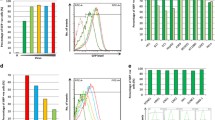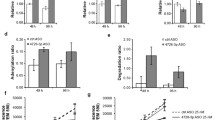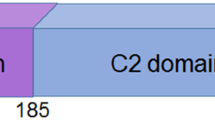Abstract
PTENP1 is a processed pseudogene of the tumour suppressor phosphatase and tensin homolog deleted on chromosome 10 (PTEN). It functions posttranscriptionally to regulate PTEN by acting as a sponge for microRNAs that target PTEN. PTENP1 therefore functions as a competitive endogenous RNA (ceRNA), competing with PTEN for binding of microRNAs (miRNA) and thereby modulating PTEN cellular abundance. Studies of the overexpression of PTENP1 all confirm its oncosuppressive function to be mediated through the suppression of cell proliferation, induction of apoptosis, and inhibition of cell migration and invasion of cancer cells of differing types. These oncosuppressive functions are a direct consequence of miRNA binding by PTENP1 and the subsequent liberation of PTEN from miRNA induced suppression. In this chapter, we will focus initially on the description of a high efficiency transient transfection method to introduce and overexpress PTENP1 in the cell type of interest, followed by accurate methodologies to measure transfection efficiency by flow cytometry. We will then continue to describe two methods to analyze cell proliferation, namely the CCK-8 assay and Click-iT® EdU assay. Due to commonalities in the manifestation of the oncosuppressive effects of PTENP1, mediated through its role as a ceRNA, the methods presented in this chapter will have wide applicability to a variety of different cell types.
Access this chapter
Tax calculation will be finalised at checkout
Purchases are for personal use only
Similar content being viewed by others
References
An Y, Furber KL, Ji S (2017) Pseudogenes regulate parental gene expression via ceRNA network. J Cell Mol Med 21(1):185–192. https://doi.org/10.1111/jcmm.12952
Poliseno L (2012) Pseudogenes: newly discovered players in human cancer. Sci Signal 5(242):re5. https://doi.org/10.1126/scisignal.2002858
Hu X, Yang L, Mo YY (2018) Role of pseudogenes in tumorigenesis. Cancers (Basel) 10(8). https://doi.org/10.3390/cancers10080256
Tang J, Ning R, Zeng B, Li Y (2016) Molecular evolution of PTEN pseudogenes in mammals. PLoS One 11(12):e0167851. https://doi.org/10.1371/journal.pone.0167851
Li W, Yang W, Wang XJ (2013) Pseudogenes: pseudo or real functional elements? J Genet Genomics 40(4):171–177. https://doi.org/10.1016/j.jgg.2013.03.003
Poliseno L, Salmena L, Zhang J, Carver B, Haveman WJ, Pandolfi PP (2010) A coding-independent function of gene and pseudogene mRNAs regulates tumour biology. Nature 465(7301):1033–1038. https://doi.org/10.1038/nature09144
Dahia PL, FitzGerald MG, Zhang X, Marsh DJ, Zheng Z, Pietsch T, von Deimling A, Haluska FG, Haber DA, Eng C (1998) A highly conserved processed PTEN pseudogene is located on chromosome band 9p21. Oncogene 16(18):2403–2406. https://doi.org/10.1038/sj.onc.1201762
Haddadi N, Lin Y, Travis G, Simpson AM, Nassif NT, McGowan EM (2018) PTEN/PTENP1: ‘Regulating the regulator of RTK-dependent PI3K/Akt signalling’, new targets for cancer therapy. Mol Cancer 17(1):37. https://doi.org/10.1186/s12943-018-0803-3
Johnsson P, Ackley A, Vidarsdottir L, Lui WO, Corcoran M, Grander D, Morris KV (2013) A pseudogene long-noncoding-RNA network regulates PTEN transcription and translation in human cells. Nat Struct Mol Biol 20(4):440–446. https://doi.org/10.1038/nsmb.2516
He L (2010) Posttranscriptional regulation of PTEN dosage by noncoding RNAs. Sci Signal 3(146):pe39. https://doi.org/10.1126/scisignal.3146pe39
Alimonti A, Carracedo A, Clohessy JG, Trotman LC, Nardella C, Egia A, Salmena L, Sampieri K, Haveman WJ, Brogi E, Richardson AL, Zhang J, Pandolfi PP (2010) Subtle variations in Pten dose determine cancer susceptibility. Nat Genet 42(5):454–458. https://doi.org/10.1038/ng.556
Hollander MC, Blumenthal GM, Dennis PA (2011) PTEN loss in the continuum of common cancers, rare syndromes and mouse models. Nat Rev Cancer 11(4):289–301. https://doi.org/10.1038/nrc3037
Berger AH, Knudson AG, Pandolfi PP (2011) A continuum model for tumour suppression. Nature 476(7359):163–169. https://doi.org/10.1038/nature10275
Salmena L, Poliseno L, Tay Y, Kats L, Pandolfi PP (2011) A ceRNA hypothesis: the Rosetta Stone of a hidden RNA language? Cell 146(3):353–358. https://doi.org/10.1016/j.cell.2011.07.014
Bartel DP (2004) MicroRNAs: genomics, biogenesis, mechanism, and function. Cell 116(2):281–297. https://doi.org/10.1016/s0092-8674(04)00045-5
Karreth FA, Pandolfi PP (2013) ceRNA cross-talk in cancer: when ce-bling rivalries go awry. Cancer Discov 3(10):1113–1121. https://doi.org/10.1158/2159-8290.CD-13-0202
Yu G, Yao W, Gumireddy K, Li A, Wang J, Xiao W, Chen K, Xiao H, Li H, Tang K, Ye Z, Huang Q, Xu H (2014) Pseudogene PTENP1 functions as a competing endogenous RNA to suppress clear-cell renal cell carcinoma progression. Mol Cancer Ther 13(12):3086–3097. https://doi.org/10.1158/1535-7163.MCT-14-0245
Liu J, Xing Y, Xu L, Chen W, Cao W, Zhang C (2017) Decreased expression of pseudogene PTENP1 promotes malignant behaviours and is associated with the poor survival of patients with HNSCC. Sci Rep 7:41179. https://doi.org/10.1038/srep41179
Zhang R, Guo Y, Ma Z, Ma G, Xue Q, Li F, Liu L (2017) Long non-coding RNA PTENP1 functions as a ceRNA to modulate PTEN level by decoying miR-106b and miR-93 in gastric cancer. Oncotarget 8(16):26079–26089. https://doi.org/10.18632/oncotarget.15317
Hu S, Xu L, Li L, Luo D, Zhao H, Li D, Peng B (2019) Overexpression of lncRNA PTENP1 suppresses glioma cell proliferation and metastasis in vitro. Onco Targets Ther 12:147–156. https://doi.org/10.2147/OTT.S182537
Qian YY, Li K, Liu QY, Liu ZS (2017) Long non-coding RNA PTENP1 interacts with miR-193a-3p to suppress cell migration and invasion through the PTEN pathway in hepatocellular carcinoma. Oncotarget 8(64):107859–107869. https://doi.org/10.18632/oncotarget.22305
Yu G, Ou ZY, Tao QY, Wan GY, Lu ZH, Lang B (2017) Role of lncRNA PTENP1 in tumorigenesis and progression of bladder cancer and the molecular mechanism. Nan Fang Yi Ke Da Xue Xue Bao 37(11):1494–1500
Zheng R, Du M, Wang X, Xu W, Liang J, Wang W, Lv Q, Qin C, Chu H, Wang M, Yuan L, Qian J, Zhang Z (2018) Exosome-transmitted long non-coding RNA PTENP1 suppresses bladder cancer progression. Mol Cancer 17(1):143. https://doi.org/10.1186/s12943-018-0880-3
Gao X, Qin T, Mao J, Zhang J, Fan S, Lu Y, Sun Z, Zhang Q, Song B, Li L (2019) PTENP1/miR-20a/PTEN axis contributes to breast cancer progression by regulating PTEN via PI3K/AKT pathway. J Exp Clin Cancer Res 38(1):256. https://doi.org/10.1186/s13046-019-1260-6
Yndestad S, Austreid E, Skaftnesmo KO, Lonning PE, Eikesdal HP (2018) Divergent activity of the pseudogene PTENP1 in ER-positive and negative breast cancer. Mol Cancer Res 16(1):78–89. https://doi.org/10.1158/1541-7786.MCR-17-0207
Li RK, Gao J, Guo LH, Huang GQ, Luo WH (2017) PTENP1 acts as a ceRNA to regulate PTEN by sponging miR-19b and explores the biological role of PTENP1 in breast cancer. Cancer Gene Ther 24(7):309–315. https://doi.org/10.1038/cgt.2017.29
Shi X, Tang X, Su L (2018) Overexpression of long noncoding RNA PTENP1 inhibits cell proliferation and migration via suppression of miR-19b in breast cancer cells. Oncol Res 26(6):869–878. https://doi.org/10.3727/096504017X15123838050075
Salic A, Mitchison TJ (2008) A chemical method for fast and sensitive detection of DNA synthesis in vivo. Proc Natl Acad Sci U S A 105(7):2415–2420. https://doi.org/10.1073/pnas.0712168105
Acknowledgments
Glena Travis is supported by the Australian Research Training Program Stipend Scholarship, and Nahal Haddadi was supported by a University of Technology Sydney International Research Scholarship.
Author information
Authors and Affiliations
Corresponding author
Editor information
Editors and Affiliations
Rights and permissions
Copyright information
© 2021 Springer Science+Business Media, LLC, part of Springer Nature
About this protocol
Cite this protocol
Travis, G., Haddadi, N., Simpson, A.M., Marsh, D.J., McGowan, E.M., Nassif, N.T. (2021). Studying the Oncosuppressive Functions of PTENP1 as a ceRNA . In: Poliseno, L. (eds) Pseudogenes. Methods in Molecular Biology, vol 2324. Humana, New York, NY. https://doi.org/10.1007/978-1-0716-1503-4_11
Download citation
DOI: https://doi.org/10.1007/978-1-0716-1503-4_11
Published:
Publisher Name: Humana, New York, NY
Print ISBN: 978-1-0716-1502-7
Online ISBN: 978-1-0716-1503-4
eBook Packages: Springer Protocols




